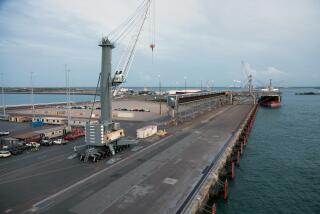Marketing the Land Down Under : John Cain, premier of Victoria, Australia, is making the rounds to sell Melbourne as the gateway to the Pacific.
When the Honorable John Cain, premier of the state of Victoria, Australia, passed through town the other day, he made a pitch to Los Angelesâ chief executives to come invest Down Under.
âThey see the place as vibrant but expensive,â Cain said in an interview after lunching with 10 chief executives at the California Club. He was en route to Puerto Rico to sell Melbourne as the site for the 1996 Olympics.
The city is up against Manchester, England; Belgrade, Yugoslavia; Atlanta; Athens, and Toronto. If Melbourne wins, the Games are expected to help channel tourism and investment into Australia--specifically Victoria, which is on the southeastern coast.
Cain is selling Melbourne as a gateway to the Pacific with its 24-hour port, the largest in the Southern Hemisphere and the 10th-largest container port in the world. With Australia increasingly aligning itself with its Asia-Pacific neighbors, Cain said his state is part of the âmost dynamic market at the moment.â
Diversifying Exports
Since January, Australia has attempted to interest other Asia-Pacific countries in uniting to promote regional economic cooperation through a so-called Pacific Rim Initiative. Earlier this month, Prime Minister Bob Hawke invited 11 countries, including the United States, to an initial meeting in Canberra in November to discuss the international economic and trade environment.
During the past few years, Australia has been restructuring its economy to be less dependent on commodity exports by diversifying into export-oriented manufacturing businesses. As part of the change, Australia has cut its effective corporate tax rate to 39% from 49% and liberalized some of the work practices of unions.
Australia has aggressively hit the road to lure foreign investors from abroad. The states of Victoria and Queensland have sent their own investment missions abroad, and each has a trade office in Los Angeles. The Victoria Investment Program, for example, is targeting the United States, United Kingdom, West Germany and Japan as primary sources of potential investment.
In the United States, the target industries are biotechnology, tourism facilities, advanced manufacturing and materials, and medical and scientific instruments.
âWe are seeking business that capitalizes on our strengths,â such as cheap energy and tax advantages for research and development, Cain said in an interview.
Major U.S. companies, he said, have discovered Australia as a strategic base for Asia-Pacific operations. They include Eastman Kodak Co., B. F. Goodrich Co., Campbell Soup Co., Control Data Corp., Hewlett-Packard Co., McDonnell Douglas Corp. and Philip Morris Inc.
Investment Applications
One-third of U.S. investment in Australia is concentrated in Melbourne, which is home for 34% of Australiaâs manufacturing industries and 26% of Australiaâs population. Victoriaâs rate of growth of non-farm gross domestic product averaged 4.6% during the past five years compared to 4.3% for all of Australia during the same period.
The United Kingdom was the biggest foreign investor in Australia at the end of 1988, with investments totaling $32.1 billion, followed by the United States with $28.6 billion and Japan with $19.3 billion.
The Australian Foreign Investment Review Board reported that in 1987-1988, applications for investment from U.S. companies totaled $1.5 billion, divided evenly among manufacturing, tourism, minerals and exploration.
Australia is also nurturing business with its Asia-Pacific neighbors. The Portland Aluminum Smelter, the largest industrial project with China to date, is a partnership involving Alcoa, the state of Victoria, First National Trust and China International Trust and Investment Corp. The smelterâs first production in 1987 brought $583.2 million in export income for Australia.
Similarly, Australian firms last year completed a light rail system in Hong Kong for the Kowloon Canton Railway Corp. worth about $216.4 million.
More to Read
Inside the business of entertainment
The Wide Shot brings you news, analysis and insights on everything from streaming wars to production â and what it all means for the future.
You may occasionally receive promotional content from the Los Angeles Times.










